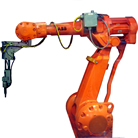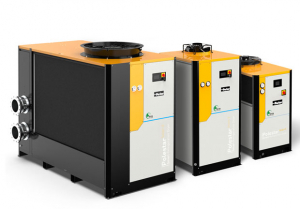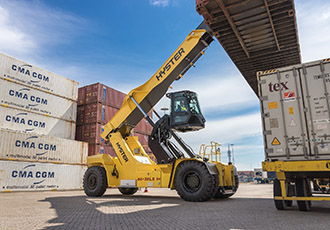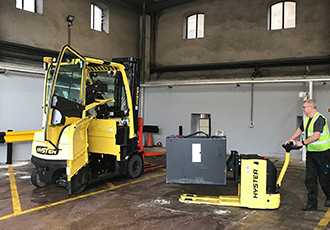Ultrasonics – The Flexible and Efficient Technology for Plastics & Packaging
22nd July 2009
Source:
Telsonic UK Limited

The plastics industry is complex with a vast range of materials and polymers used to manufacture a multitude of products for industries as diverse as Automotive, Medical Device, Pharmaceuticals, Packaging, Electronics and Aerospace. Within each of these industries there is a requirement to perform one or more operations such as Welding, Cutting, Sealing or Forming on plastic components and historically manufacturers have used several different technologies to achieve these objectives. Ultrasonics however, is a technology which is now being applied to an ever increasing number of applications due to the combined benefits of inherent flexibility, low energy consumption and precise process control.
Reducing costs and increasing efficiency
Traditional technologies used in conjunction with plastics and polymers include hot air / cold staking, vibration welding, hot plate welding, heat sealing, adhesives and riveting. The drive to continue to reduce energy consumption and costs means that the processes which require continuous heat are under scrutiny as an efficient option. All manufacturers are under pressure to reduce production costs and if additional components, such as rivets or other fasteners, can be eliminated then there is a tangible ongoing saving in material costs. The rigorous standards which must be maintained when using adhesives and chemicals, together with the ongoing raw material costs, mean that the use of these products is also becoming questionable in certain cases. By comparison, Ultrasonic technology offers an extremely energy efficient alternative to many joining and sealing applications with the added benefits of cleanliness, precise process control and no consumables.
Flexible Concepts and Emerging Techniques
The compact configuration of the Ultrasonic process allows the technology to be applied in a diverse number of ways. For simple applications where there is only a small number of “staking” or welding points, a hand held unit provides a low cost yet efficient joining solution. This same single point configuration can also be manipulated easily using a robot system for applications which may have a higher number of “staking” points in a complex configuration or where there are multiple part variants. The simple hand held, single point unit is also an ideal “back up” tool which can be used for new product evaluation or for rework purposes. Standard bench top machines offer a cost effective solution to a wide variety of applications and can be tooled to weld rigid substrate parts, multi tip stake or spot weld joints. Even film or textile seams can be welded with this type of system, providing all of the process control benefits of Ultrasonics combined with extremely fast cycle times. These systems can either be free standing manually loaded and unloaded machines of a standard design, or bespoke special purpose designs. Alternatively, the Ultrasonic head systems can be fully integrated within the production line for fully automatic part presentation and processing.
The attributes of flexibility, control and efficiency has seen Ultrasonics adopted as the preferred joining solution to many high volume applications, typically within the automotive industry, where it is used to produce components such as interior door panels, instrument panels, under bonnet components and any vehicle part requiring the attachment of sound or heat insulation substrates. In this type of machine it is not uncommon to have high numbers of sonotrodes operating on complex three dimensional components.
Growing areas for the use of Ultrasonic technology include the medical device and packaging industries. Although used in many areas within the medical device industry for some years, the range of medical applications to which the technology could be applied is now expanding rapidly as new techniques have been developed by Telsonic. Previously, there was potential for damage to delicate membrane components when applying conventional Ultrasonic principals which generate amplitudes in the vertical plane and which can induce a “diaphragming” effect on a film or membrane. This causes the film or membrane to resonate which in turn can cause pin-holes or other damage. Particulate generation by the process was also a concern.
A new innovation from Telsonic is “Soniqtwist” which has greatly expanded the application areas for Ultrasonics within the medical device industry. “Soniqtwist” differs from the conventional process by using reciprocal circumferential amplitudes, in the horizontal plane, and therefore does not generate the acoustic stresses found when using the conventional configuration and thus eliminating the possibility of damage to delicate films or membranes . A further benefit of “Soniqtwist” is that no cavitation of the plastic takes place in the vertical plane, significantly reducing the opportunity for particulate generation. The “Soniqtwist” principals also mean that thin wall section components can now be welded more easily with reduced applied force and shallower weld penetrations. Other innovative applications which have been developed for the medical device industry and using this process include component forming, encapsulation and the generation of “easy open” or “break off – tamper evident” features on components.
The packaging industry is also embracing the use of Ultrasonics as an alternative to the traditional heat / impulse sealing process. The main drivers here are seal integrity borne from process control, as the level of control available from Ultrasonics far exceed that of traditional sealing methods, plus the significant energy savings generated when using Ultrasonics, as the process only uses energy when actually creating the seals, with little or no energy being consumed between sealing cycles.
With the capability to be applied across a broad range of industries and applications, configured in many different ways and providing precise process control with low energy consumption, there can be few if any other technologies which can claim to be operating with such diversity.
Traditional technologies used in conjunction with plastics and polymers include hot air / cold staking, vibration welding, hot plate welding, heat sealing, adhesives and riveting. The drive to continue to reduce energy consumption and costs means that the processes which require continuous heat are under scrutiny as an efficient option. All manufacturers are under pressure to reduce production costs and if additional components, such as rivets or other fasteners, can be eliminated then there is a tangible ongoing saving in material costs. The rigorous standards which must be maintained when using adhesives and chemicals, together with the ongoing raw material costs, mean that the use of these products is also becoming questionable in certain cases. By comparison, Ultrasonic technology offers an extremely energy efficient alternative to many joining and sealing applications with the added benefits of cleanliness, precise process control and no consumables.
Flexible Concepts and Emerging Techniques
The compact configuration of the Ultrasonic process allows the technology to be applied in a diverse number of ways. For simple applications where there is only a small number of “staking” or welding points, a hand held unit provides a low cost yet efficient joining solution. This same single point configuration can also be manipulated easily using a robot system for applications which may have a higher number of “staking” points in a complex configuration or where there are multiple part variants. The simple hand held, single point unit is also an ideal “back up” tool which can be used for new product evaluation or for rework purposes. Standard bench top machines offer a cost effective solution to a wide variety of applications and can be tooled to weld rigid substrate parts, multi tip stake or spot weld joints. Even film or textile seams can be welded with this type of system, providing all of the process control benefits of Ultrasonics combined with extremely fast cycle times. These systems can either be free standing manually loaded and unloaded machines of a standard design, or bespoke special purpose designs. Alternatively, the Ultrasonic head systems can be fully integrated within the production line for fully automatic part presentation and processing.
The attributes of flexibility, control and efficiency has seen Ultrasonics adopted as the preferred joining solution to many high volume applications, typically within the automotive industry, where it is used to produce components such as interior door panels, instrument panels, under bonnet components and any vehicle part requiring the attachment of sound or heat insulation substrates. In this type of machine it is not uncommon to have high numbers of sonotrodes operating on complex three dimensional components.
Growing areas for the use of Ultrasonic technology include the medical device and packaging industries. Although used in many areas within the medical device industry for some years, the range of medical applications to which the technology could be applied is now expanding rapidly as new techniques have been developed by Telsonic. Previously, there was potential for damage to delicate membrane components when applying conventional Ultrasonic principals which generate amplitudes in the vertical plane and which can induce a “diaphragming” effect on a film or membrane. This causes the film or membrane to resonate which in turn can cause pin-holes or other damage. Particulate generation by the process was also a concern.
A new innovation from Telsonic is “Soniqtwist” which has greatly expanded the application areas for Ultrasonics within the medical device industry. “Soniqtwist” differs from the conventional process by using reciprocal circumferential amplitudes, in the horizontal plane, and therefore does not generate the acoustic stresses found when using the conventional configuration and thus eliminating the possibility of damage to delicate films or membranes . A further benefit of “Soniqtwist” is that no cavitation of the plastic takes place in the vertical plane, significantly reducing the opportunity for particulate generation. The “Soniqtwist” principals also mean that thin wall section components can now be welded more easily with reduced applied force and shallower weld penetrations. Other innovative applications which have been developed for the medical device industry and using this process include component forming, encapsulation and the generation of “easy open” or “break off – tamper evident” features on components.
The packaging industry is also embracing the use of Ultrasonics as an alternative to the traditional heat / impulse sealing process. The main drivers here are seal integrity borne from process control, as the level of control available from Ultrasonics far exceed that of traditional sealing methods, plus the significant energy savings generated when using Ultrasonics, as the process only uses energy when actually creating the seals, with little or no energy being consumed between sealing cycles.
With the capability to be applied across a broad range of industries and applications, configured in many different ways and providing precise process control with low energy consumption, there can be few if any other technologies which can claim to be operating with such diversity.
Similar articles
More from Telsonic UK Limited
- Telsonic Showcase New Ultrasonic Packaging Technology at Total Processing & Packaging 2010 11th March 2010
- Telsonic UK Limited to Showcase New Technologies and Concepts at PDM 2010 11th March 2010
- Ultrasonic Welding - Design for Successful Production 7th March 2010
- Telsonic Keep Ultrasonics Safe and Sound 2nd December 2009




.jpg)







Write a comment
No comments